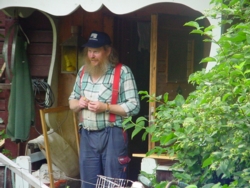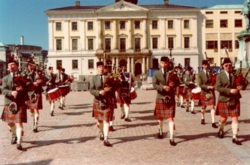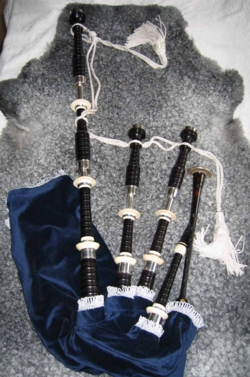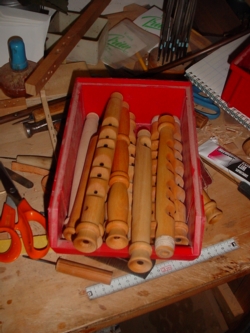Playing and Handling Bagpipes
Two Swedish Cases [1]
Gunnar Ternhag
[1]
The relationship between musicians and makers of musical instruments is fascinating, indeed. First of all, musicians and instrument-makers are dependent upon each other. Even if appears to be a truism, at least for readers interested in organology, the point is an important one: The dependence is seldom spoken about or visible. The two groups, the musicians and the builders, are separated within the musicological discourses. Only on rare occasions does one pay attention to the relation between them. It seems to be some kind of tacit knowledge that these categories interact, and relatively few investigations have been made about this fundamental fact. Secondly, the relationships between musicians and makers of musical instruments take many forms. This is also evident to organologists, yet not often demonstrated and documented. The variations reach from one extreme to another: from one with two definitely separated specialists with no shared tasks, to another with one single person who combines music making with making instruments. There are in fact countless examples along this spectrum.
The musician and the instrument-maker are one and the same
The musician and the instrument-maker are two distinct specialists
[2] Interaction between musicians and makers of musical instruments
The specialists favoring separate discourses are mostly found in Western art music, where musicians usually hand over the care of their readymade instruments to skilled craftsmen. And hardly ever do these musicians manufacture their own instruments (there a few exceptions within the avant-garde world, including composer/performers such as Harry Partch, who perform their own music on their own instruments). The most extreme cases are perhaps found in connection with acoustic keyboard-instruments of all sorts, where musicians rarely do anything more than touch the keys. One very striking example is the church organ, which is manufactured in an industrial setting or large workshop, installed by representatives from the workshop, and continuously tuned by specialists. While the church organist plays and occasionally tunes a few of the reed pipes, it is very symptomatic that most manuals in organ playing have no instructions about how to manage mechanical or tuning problems in the instruments.
In other musical genres musicians normally make and repair their instruments. This is the case in many so-called folk-music cultures.[2] For simple instruments, this combination of maker and musician is obvious. Everyone with a small amount of craftsmanship can make his or her own cow’s horn or willow flute. Considerably more training-both as a musician and as a craftsman-is needed to produce more complicated instruments. In spite of that fact, it is rather easy to find examples of instrument-making musicians-and vice versa. Some very accidental finds in the existing literature show that this combination is spread all over Europe. Let us just briefly discuss one example. The most famous player of the Swedish nyckelharpa [keyed fiddle] was Eric Sahlström (1912–1986), who also was a highly esteemed maker of the instrument. But he is far from the only nyckelharpa-player with extensive experiences from making the instrument, which Jan Ling (1967) has demonstrated. In the 1970s, there was a boom in both making and playing the nyckelharpa in Sweden, for the most part inspired by Sahlström’s well functioning and beautiful instruments (Ahlbäck 1980). There are several other examples (Ahrens 1981, Gojković 1981, Lundberg 1994, for example).
Still the most common types of relations between musicians and makers of musical instruments are not at the extreme points on the graph above. Usually musicians have not made their own instruments, but are nevertheless familiar with the handling of them. When an instrument has to be repaired, many musicians do the mending themselves. A great number of musicians are even keen to develop their dear instruments, for instance improving the sound or the playing abilities. The everyday care of instruments is in fact so common and so necessary that the term musician is misleading, if it is not understood to include a bit of craftsmanship.
The purpose with this short article is to contribute to the study of the relation between the two categories. It will do so by elucidating the relation in two specific cases-and then comparing them. Both cases are Swedish. Although different, they have one essential factor in common, namely the instrument.
[3] The Swedish Bagpipe[3]
The bagpipe has a long history in Sweden.[4] Medieval church-paintings depict the instrument well before the reformation. There are also quite a few written sources, which tell about the use of the instrument. However, it could be questioned whether or not the bagpipe was a widespread and popular instrument.
It is usually stated that the last Swedish bagpipe-player with hereditary knowledge about the instrument died in 1949. Gudmunds Nils Larsson lived in Dala-Järna in the middle of Sweden, where he occasionally played his rather simple instrument. He was neither a very active musician, nor were any of his tunes recorded.
The revival of the domestic bagpipe in Sweden started at the end of the 1970s.[5] The substantial sources for the pioneers were a number of preserved instruments in museums and a limited number of recorded tunes.[6] Thanks to some hard working enthusiasts, the domestic bagpipe was re-introduced after a few years. Special festivals for bagpipe lovers were held, special courses in making and playing bagpipes were arranged, and the bagpipe was played on gramophone records, heard in radio and seen in television. In a remarkably short time, the bagpipe was established on the Swedish folk music scene. Both the musicians and the audience seem to have been waiting for the comeback of the instrument.[7]
Two names must be mentioned in connection with this noteworthy revival: Leif Eriksson and Per Gudmundson. Leif Eriksson was, and still is, a talented maker of musical instruments, among them bagpipes. Per Gudmundson is a gifted folk musician, who plays both violin and bagpipe. Without Leif Eriksson’s excellent bagpipes and Per Gudmundson’s eminent ability to use them, there would never have been such a quick development of the revival.
An essential part of the revival has in fact been the scientific activity around the bagpipe, studying both the old tradition of the instrument and today’s struggle to give the instrument a new life.[8] As is the case nowadays, ethnomusicologists have been deeply involved in the revival-movement. One could even say that part of the revival is the scientific descriptions and discussions. The scientific handling has the function to reflect the revival and make it visible. The scientists also have the crucial power to authorize the revived bagpipe.
[4] The Scottish Highland bagpipe in Sweden[9]
The Highland bagpipe is a truly powerful musical instrument. Both its sound and its size create a feeling of absolute power. For obvious reasons, its military connections contribute to strengthening this impression.[10] Its history, which is described in both scientific and popular literature, dates back to before the days of the Scottish clan system.[11] The use of bagpipes in Scottish armies is known from the seventeenth century. As early as 1781, the first piping competition was arranged in order to promote the interest for the instrument and its music. Military piping and competitions have effectively contributed to keep the playing of the Highland bagpipe on a high level. Today, the Scottish Highland bagpipe is a well-established icon for Scottishness and certainly the most well-known type of bagpipe.
The first attempts to introduce the Highland bagpipe in Sweden were made by a few enthusiasts in the middle of the 1960s.[12] The impulse to take up not only the instrument, but also its entire culture: the music, terminology, clothing, and its specific style, came from visiting Scottish pipe bands or from television programs with impressive Scottish piping. The very first Swedish pipe band was formed in Stockholm in 1968: The Thistle Pipe Band, still existing, although it has undergone several reconfigurations. The band was soon enlarged with drummers in accordance with the Scottish tradition: side-, tenor- and bass-drums. The Thistle Pipe Band drew many listeners’ attention to the instrument and its music, and attracted a number of new pipers. After some years new ensembles and bands were founded, in Stockholm as well as in Malmö and Göteborg. The Scottish Highland bagpipe had gotten a foothold in Sweden.
The inspiration came in fact not only from Scotland. Already in 1948, a Danish painter, Mogens Zieler, began playing the instrument and one year later he founded The Pipers’ Club of Copenhagen together with some piping friends. Since those days, the interest for playing the Highland bagpipe-and the Scottish drums-has been stronger in Denmark than in Sweden. There is much cooperation between Danish and Swedish pipers: common workshops, Swedish instructors in Danish courses and vice versa, and yearly competitions. Scottish piping and drumming could not have been developed in Sweden, at least not to their present state, without the support from colleagues in Denmark.
For many years Scottish piping in Sweden was influenced by the military use of the instrument. Scottish military pipe-bands were seen as a model for the Swedish ensembles, although very few of them had any formal military connection. In contrast, some of the Swedish players were military officers. The military influences resulted in a concentration upon performances in military style, like their Scottish counterparts. Today the Swedish bagpipe players are interested, above all, in the Scottish music itself.
Musicologist Mats d Hermansson (2003) estimates that there are between 200 and 250 active pipers and drummers in the Scandinavian countries. The number of active Highland pipers in Sweden, then, is less than 100, perhaps closer to 50 than to 100. The piping community in Sweden is small, “marginal” according to Hermansson (2003:6). In spite of that, there are enough devoted players in Sweden to form a functioning community.
[5] Handling the Swedish bagpipe
When the pioneers started to revive the Swedish bagpipe, they had no knowledge about how to make and handle the instrument. The making of the instrument departed from preserved bagpipes, and manufactured with a trial-and-error approach. The most important maker was Leif Eriksson-he even published a manual for making Swedish bagpipes, in order to facilitate the work for beginners-but he was not the only one. Actually, it is a distinctive trait of the revival that the making of instruments has been spread upon many hands.
There are consequently several persons who combine making bagpipes with playing the instrument. Roughly twenty percent of all players have made their own instrument (Boström 1996:32). Most of these did not make instruments in order to sell them, but to play them. Their interest comprises both the instrument and its repertoire. One of them says very typically that he regards himself as “a user of the tradition and a developer, rather than a preserver.”[13] Another maker/player heard and saw the Swedish bagpipe for the first time at a folk music festival in western Sweden. He remembers his reaction: “When I returned from that festival, I knew I must buy a lathe” (Boström 1997:18). It is typical that he did not try to buy an instrument, which had been the shortest way to the music, but to make one. Thus, these men and their like-minded belong to one of the extreme points, mentioned in the introduction. Making and playing the bagpipe are intertwined activities, impossible to separate from each other. “Only” playing a bagpipe would not satisfy their curiosity and their abilities.
Even if the remaining eighty percent of the players have bought their bagpipes, most of them are not at all passive users of their beloved instruments. They must, for instance, make their own reeds, as there are hardly any ready-made ones to purchase. The pioneers were very aware of this part of the musicianship. When the first course for bagpipe-players was held, it comprised the making of reeds, “which is the main obstacle for beginners”(Gudmundson 1990:275). Since then every course or workshop for beginners includes segments in reed making.
A study of bagpipe-owners confirms that the instrument is demanding (Boström 1996:24 f). The making of reeds is in itself a problem that requires a bit of craftsmanship and lots of patience. The reed-problem is also crucial for tuning both the chanter and the drone-pipe. But the sack can cause problems too. “Leaks, stiffness of the leather and wrong sorts of leather” were the most common problems reported by the informants. A player summarized his experiences by saying that “the bagpipe must be handled with the same care as an infant with ongoing colic.”
It is certainly not an exaggeration to state that most players of the Swedish bagpipe are more than players. To handle the instrument is an integrated part of the musicianship. Without an interest for the instrument itself it is hardly possible to be a successful bagpiper. Someone has even suggested that the most common topic among bagpipers is the reed-problem. But this important prerequisite is rarely written about or talked about publicly. It seems to be something that a wannabe either must learn the hard way or is socialized into by experienced pipers.
[6] Handling the Scottish Highland bagpipe
Practically everyone who plays the Highland bagpipe in Sweden has bought their instrument.[14] Some of pioneers purchased their first instruments in music stores in Copenhagen or Oslo. Some of these instruments were of Pakistani origin, and much cheaper than the ones made in Scotland (Hermansson 2003:197). After a while, they discovered several defects, for instance leaking sacks or imperfect drilled chanters, and ordered new instruments from Scotland. Others purchased their first instruments in Scotland, ordering them from a Scottish dealer or directly from a maker in Scotland.
Beginners have commonly started out by buying both an instrument and a manual. Nowadays, manuals are generally replaced by courses and training in existing bands, even if some beginners still use these written instructions. An instrument plus a manual can be conceived of as a kind of practical starting-kit, resulting in sounding music in as short time as possible. The starting-kit often includes a practice chanter, which gives good opportunities to improve the playing technique.
“Once contacts had been established with Scottish pipe makers, instruments and accessories were increasingly acquired by mail order”, Hermansson writes (Hermansson 2003:222). This circumstance tells us two things. Firstly, players of Highland bagpipes in Sweden have a well-functioning network, which provides the people involved with, for instance, addresses to competent pipe-makers. Secondly, by purchasing instruments from Scottish makers the Swedish players also buy authenticity. To have an authentic instrument-and an overall authentic image as a player of the Highland bagpipe in Sweden-is evidently important. With their music, their instruments, their dress and their way of performing, the players do strive to be “genuine” Scotsmen.
There is a Swedish maker of Highland bagpipes, Rolf Littorin, living in Onsala, south of Göteborg, “the only Scandinavian who has engaged seriously in the making of Highland bagpipes,” according to Hermansson (2003:300 ff.). He started with making practice chanters, then pipe chanters, which is the most delicate part of the instrument. Later on, he began making full sets of pipes. Rolf Littorin is self-taught as a pipe maker, although he has had contacts with some prominent Scottish makers. His customers seem to be mostly Swedes, which is understandable. Even if his makes excellent instruments, they will never be regarded as authentic.
The reeds of the Scottish Highland bagpipe are probably easier to manage than the reeds of the Swedish bagpipe. Highland pipers can rely on ready-made reeds, which are more stable and reliable than Swedish pipers’ self-made ones. Still, every player of reed instruments is more or less constantly busy with checking and improving the reeds. The Highland pipers are therefore not free from reed-problems, but are freer from them than the players of the Swedish bagpipe.
To sum up, as the Highland pipers in Sweden have bought their instruments, they resemble many other musicians. A certain circumstance is yet, that the Highland pipers turn their interest towards Scotland and most likely purchase instruments from there. A close relation to the maker of the instrument in question is not possible. On the other hand, the Scottish bagpipes are regarded as authentic, which gives them an essential quality.
[7] Discussion
It is striking that the revival of the Swedish bagpipe and the introduction of the Scottish Highland bagpipe in Sweden have preceded simultaneously. The revival and the introduction have been parallel, rather than interconnected, processes. This mixture of similarity and divergence makes a good starting point for our discussion.
The revival of the Swedish bagpipe began with almost no existing knowledge about how to make and handle the instrument, while the introduction of the Scottish Highland bagpipe in Sweden could rely on a great variety of experiences available in Scotland and Denmark. The revival process of the Swedish bagpipe was open, so to speak. Several makers were involved; many of them were also musicians or closely connected to potential players of the instrument. Consequently, the number of makers resulted in a great variety of instruments. The Swedish bagpipe, then, was not developed to a standard model, but came to constitute a set of similar instruments.
An important requirement for the first makers of the Swedish bagpipe was that the instrument should not be used in bagpipe bands, like the Scottish ones. There was no need to make the different instruments uniform. Instead, they had to be adapted to ensembles where the violin played a major role. This adaptation pointed towards some degree of uniformity, insofaras playing with violins required instruments with a good intonation and a moderate sound.
The Highland pipe, on the other hand, was already a fixed instrument when the first Swedes purchased their instruments. There was no space, or need, for experiments in order to develop the bagpipe in its new environment. On the contrary, these musicians were looking for “real” Scottish bagpipes. Not changing the instruments was part of their aesthetics.
On the whole, playing and handling both bagpipes have followed these respective patterns. The Swedish bagpipe is still more demanding for the musicians, in the sense that they have to work more with their instruments. And they most likely have a close and ongoing relationship with the makers of the instruments if they themselves have not made their own bagpipes. As shown above, many of the players have chosen the Swedish bagpipe because they want to be involved in all aspects of the instrument, not only playing it.
The players of the Highland bagpipe can actually spend more time with the music, as the instruments do not need so much care. Handling of the reeds can now and then cause problems, but the same goes for players of other reed instruments.
Returning to the introductory line where different relations between musicians and instrument-makers can be placed, it is obvious that the Swedish bagpipe and the Highland bagpipe in Sweden have different positions. The Swedish bagpipe, with its relatively close connection between musicians and instrument makers, is close to the point where the musician and the maker are the same person. This position in itself shows that the Swedish bagpipe belongs to the so-called folk music instruments.
The Highland bagpipe, as it is played and handled in Sweden, is considerably closer to the point where playing and making the instrument is divided between two different specialists.
Although organologically related, the two bagpipes are not at all alike when it comes to the relation between musicians and instrument-makers. Only listening to the instruments will not reveal this notable difference. It will, however, appear before and after the music sounds.
References
Ahrens, Christian 1981. “Ein griechischer Volksmusiker und sein Instrument. Zur Stimmung folkloristischer Aerophone.” Studia Instrumentorum Musicae Popularis VII. Erich Stockmann (ed.). Stockholm: Music museum, pp. 95- 101.
Ahlbäck, Gunnar 1980. Nyckelharpsfolket. Stockholm: LTs förlag.
Allmo, Per-Ulf (ed.) 1990. Säckpipan i Norden. Stockholm: Förlaget AllWin.
Bohlman, Philip V. 1992. “The Music Culture of Europe.” Excursions in World Music. Bruno Nettl, et al. (eds.) Upper Saddle River, New Jersey: Prentice Hall, pp. 191–222.
Boström, Mathias 1996. Hämningslöst eller uppgivet. Om svenskt säckpipspel och svenska säckpipare. Essay written in the Department of musicology, Uppsala University.
Boström, Mathias 1997. Sökare med säckpipa. Om tre säckpipare av idag. Master thesis. Department of musicology, Uppsala University.
Canon, Roderick 1995. The Highland Bagpipe and its Music. Edinburgh.
Donaldson, William 2000. The Highland Pipe and the Scottish Society 1750–1950. East Linton.
Gojković, Andrijana 1981. “Ein serbischer Maultrommelspieler.” Studie Instrumentorum Musicae Popularis VII. Erich Stockmann (ed.). Stockholm: Music Museum, pp. 149–152.
Gudmundson, Per 1990. “Djäwul’ns blåsbeöl’e. Om säckpipans uppgång, fall och återuppståndelse.” Musik och kultur. Owe Ronström (ed.). Lund: Studentlitteratur, pp. 247–290.
Hermansson, Mats d 2003. From Icon to Identity. Scottish Piping & Drumming in Scandinavia. (Publications from the Department of Musicology, Göteborg University No. 75.) Göteborg.
Kaufman Shelemay, Kay 2001. Soundscapes. Exploring music in a changing world. New York & London: W.W. Norton.
Ling, Jan 1967. Nyckelharpa. Studier av ett folkligt musikinstrument. Stockholm: P A Norstedts & Söners förlag.
Lundberg, Dan 1994. Persikoträdgårdarnas musik. En studie av modal improvisation i turkisk folk- och populärmusik baserad på improvisationer av Ziya Aytekin. (Studies in Musicology 3.). Stockholm: Department of Musicology, Stockholm University.
Rehnberg, Mats 1943. Säckpipan i Sverige. Stockholm: Nordiska museet.
Ronström, Owe 1989. “Making use of history. The revival of the bagpipe in Sweden in the 1980s.” Yearbook of Traditional Music, vol. XXI, 1989, pp. 95–108.
Ternhag, Gunnar 1994. “Folkmusikens instrument i Sverige : om spel och forskning, var för sig och tillsammans.” Folk och musik 1994, pp.9–26.
Torp, Lisbet 1998. “Bliver man skotte af at spille på sækkepibe?” Musikkens tjenere. Instrument-Forsker-Musiker. Müller, Mette & Torp, Lisbet (eds.). Copenhagen: Musichistoric Museum.
Notes
[1] Many thanks to Mats d Hermansson for several corrections and suggestions-and for delivering two of the photos.
[2] Philip V. Bohlman (1992:210) refers to a common view when he states that “many thought that a folk instrument was one built by its player, therefore functioning ideally for the player’s needs.”
[3] There is, of course, no “Swedish” bagpipe. There are several types of bagpipes in Sweden and the bagpipe as such is certainly not Swedish. But the revived bagpipe in Sweden is considered “Swedish” by makers and musicians. I therefore use this denomination in my text.
[4] See Rehnberg 1943, Gudmundson 1990 and Allmo 1990: 47–144, where the history of the bagpipe in Sweden is described (in Swedish).
[5] The revival process in described in Ronström 1989, Allmo 1990:155–196; Gudmundson 1990:272 ff.
[6] Many of the recorded tunes are published in Gudmundson 1990:280ff.
[7] See the following web-site for a comprehensive presentation in English of the Swedish bagpipe: <http://user.it.uu.se/~crwth/bagpipes/swedish/index.html>
[8] Ronström 1989; Gudmundson 1990; Allmo 1990. Cf Ternhag 1994:19 ff.
[9] Neither is there any “Scottish” bagpipe, although the so-called Highland bagpipe (or Great Highland bagpipe) usually is preceeded by the word “Scottish.” Cf Torp 1998.
[10] See Kaufman Shelemay 2001:45 for an organological description of the instrument.
[11] Canon 1995; Donaldson 2000; Hermansson 2003:33–87. See Kaufman Shelemay 2001: 42 for an overview.
[12] All facts about the introduction come from Hermansson 2003.
[13] Boström 1997:29. All translations below are mine.
[14] All facts in this part are from Hermansson 2003:220 ff.




